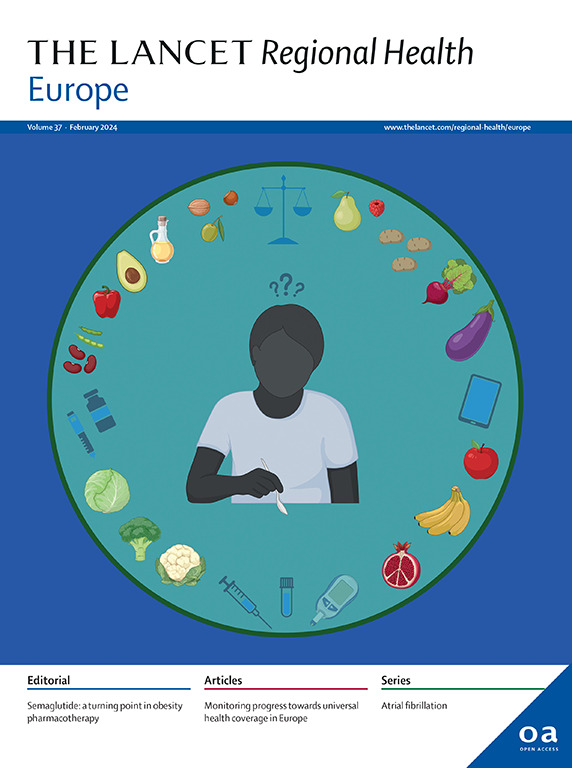Risk factors for dementia and cognitive impairment within 5 years after stroke: a prospective multicentre cohort study
IF 13
Q1 HEALTH CARE SCIENCES & SERVICES
引用次数: 0
Abstract
Background
Stroke survivors frequently experience subsequent cognitive impairment or dementia. We aimed to identify risk factors for post-stroke dementia (PSD) and cognitive impairment (PSCI) within 5 years after stroke.
Methods
The DEMDAS (German Center for Neurological Diseases (DZNE) mechanisms of dementia after stroke) study is a prospective cohort of stroke patients admitted to six German tertiary stroke centres between May 1, 2011 and January 31, 2019. Eligible dementia-free patients with ischaemic or haemorrhagic stroke underwent baseline examinations and regular clinical, neuropsychological, and neuroimaging follow-ups over 5 years, with the last follow-ups completed in January 2024. PSD was the primary outcome, determined by comprehensive cognitive testing, patient and informant interviews, and review of medical records. The secondary outcomes were early-onset PSD (3–6 months), delayed-onset PSD (>6 months), and PSCI. Associations between baseline risk factors and PSD were assessed using Cox regression models adjusted for age, sex, education, and stroke severity.
Findings
Of 736 patients (245 [33%] female, mean age 68·0 years [SD 11·2], median admission National Institutes of Health Stroke Scale (NIHSS) 3 [IQR 1–5]), 557 (76%) were followed up until death or the end of the study, and 706 (96%) contributed to the PSD analysis. During a median of 5·0 years [IQR 3·3–5·1] of follow-up, 55 new dementia cases were diagnosed (6-month incidence: 3·1% [1·8–4·5], 5-year incidence: 8·8% [6·5–11·1]), of which 21 (38%) were classified as early-onset PSD. The 5-year risk of PSD was associated with older age (HR 1·13 [95% CI 1·08–1·18] per year), higher stroke severity (1·08 [1·03–1·13] per point on NIHSS), lower educational attainment (1·16 [1·05–1·28] per year), acute phase cognitive impairment (5·86 [2·21–15·58]), lower Barthel Index (1·10 [1·05–1·16] per 5 points less), atrial fibrillation (1·91 [1·10–3·30]), metabolic syndrome (MetS, 2·05 [1·15–3·64]), particularly reduced high-density lipoprotein cholesterol (HDL-C, 2·61 [1·50–4·52]) and pre-/diabetes mellitus (2·13 [1·13–4·00]), imaging markers of small vessel disease, and stroke recurrence during follow-up (2·36 [1·16–4·83]). Patients who received acute reperfusion treatment had a 65% lower risk of PSD than those who did not (0·35 [0·16–0·77]). While factors related to the severity of the index stroke were more strongly associated with early-onset PSD, MetS showed a stronger association with delayed-onset PSD. The association between MetS and PSD was independent of stroke recurrence and consistent across age subgroups, with 5-year cumulative incidence ranging from 1·7% (0·0–4·0) in patients ≤65 years without MetS to 24·5% (14·3–33·4) in patients ≥74 years with MetS.
Interpretation
The risk of dementia after stroke is multifactorial, with differing risk profiles for early-onset and delayed-onset PSD. Metabolic syndrome, including reduced HDL-C, emerged as a novel risk factor and potential target for PSD prevention.
Funding
German Center for Neurodegenerative Diseases (DZNE).
脑卒中后5年内痴呆和认知障碍的危险因素:一项前瞻性多中心队列研究
中风幸存者经常会出现认知障碍或痴呆。我们的目的是确定中风后5年内脑卒中后痴呆(PSD)和认知障碍(PSCI)的危险因素。DEMDAS(德国神经疾病中心(DZNE)脑卒中后痴呆机制)研究是一项前瞻性队列研究,研究对象是2011年5月1日至2019年1月31日期间在6家德国三级脑卒中中心住院的脑卒中患者。符合条件的无痴呆缺血性或出血性卒中患者接受了基线检查和常规临床、神经心理学和神经影像学随访,随访时间超过5年,最后一次随访于2024年1月完成。通过综合认知测试、患者和信息提供者访谈以及对医疗记录的审查来确定PSD是主要结局。次要结局为早发性PSD(3-6个月)、迟发性PSD(6个月)和PSCI。基线危险因素与PSD之间的关联使用Cox回归模型进行评估,校正了年龄、性别、教育程度和中风严重程度。结果736例患者中,女性245例(33%),平均年龄68.5岁(SD 11.2),入院中位数为美国国立卫生研究院卒中量表(NIHSS) 3 (IQR 1-5), 557例(76%)被随访至死亡或研究结束,706例(96%)被纳入PSD分析。在中位随访5年[IQR 3·5·1]期间,新发痴呆病例55例(6个月发病率3.1%[1·8 - 4·5],5年发病率8.8%[6·5 - 11·1]),其中21例(38%)为早发性PSD。PSD的5年风险与年龄较大(HR为1.13 [95% CI为1.08 - 1.18]/年)、卒中严重程度较高(NIHSS评分为1.08[1.03 - 1·13]/年)、受教育程度较低(1.16[1.05 - 1·28]/年)、急性期认知功能障碍(5.86[2.21 - 15.58])、较低的Barthel指数(1.10[1.05 - 1·16]/低5分)、心房颤动(1.91[1.10 - 3.30])、代谢综合征(2.05[1.15 - 3.64]),特别是高密度脂蛋白胆固醇(HDL-C)、2·61[1·50-4·52])、糖尿病前期(2·13[1·13 - 4·00])、小血管病变影像学指标、随访期间卒中复发(2·36[1·16-4·83])。接受急性再灌注治疗的患者发生PSD的风险比未接受急性再灌注治疗的患者低65%(0.35[0.16 - 0.77])。虽然与指数卒中严重程度相关的因素与早发性PSD的相关性更强,但MetS与晚发性PSD的相关性更强。MetS和PSD之间的关联与卒中复发无关,并且在各个年龄亚组中是一致的,5年累积发病率从≤65岁无MetS患者的1.7%(0 - 4.0)到≥74岁met患者的24.5%(14.3 - 33.4)不等。脑卒中后痴呆的风险是多因素的,早发性和晚发性PSD具有不同的风险特征。代谢综合征,包括降低HDL-C,成为新的危险因素和预防PSD的潜在目标。资助德国神经退行性疾病中心(DZNE)。
本文章由计算机程序翻译,如有差异,请以英文原文为准。
求助全文
约1分钟内获得全文
求助全文
来源期刊

Lancet Regional Health-Europe
Multiple-
CiteScore
19.90
自引率
1.40%
发文量
260
审稿时长
9 weeks
期刊介绍:
The Lancet Regional Health – Europe, a gold open access journal, is part of The Lancet's global effort to promote healthcare quality and accessibility worldwide. It focuses on advancing clinical practice and health policy in the European region to enhance health outcomes. The journal publishes high-quality original research advocating changes in clinical practice and health policy. It also includes reviews, commentaries, and opinion pieces on regional health topics, such as infection and disease prevention, healthy aging, and reducing health disparities.
 求助内容:
求助内容: 应助结果提醒方式:
应助结果提醒方式:


